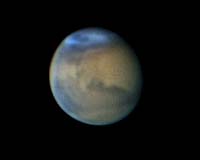 |
Washington (AFP) June 18, 2009 NASA successfully blasted two probes into space Thursday on a landmark lunar exploration mission to scout water sources and landing sites in anticipation of sending mankind back to the moon in 2020. The launch marked "America's first step in a lasting return to the moon," a NASA official said moments after a rocket carrying the probes launched at 5:32 pm (2132 GMT), one day after the US space agency scrubbed the shuttle Endeavour launch for the second time in a week because of a nagging hydrogen fuel leak. The liftoff of the dual LRO and LCROSS missions atop an Atlas V rocket from Florida's Cape Canaveral Air Force Station, adjacent to Kennedy Space Center, took place one month shy of the 40th anniversary of NASA's historic first landings on Earth's natural satellite in 1969. Americans have been the only astronauts to walk on the moon -- with the last such outing in 1972 -- and the new mission is the first step on the long journey to launch manned missions further into our solar system, to the planet Mars and beyond, from lunar colonies. US President Barack Obama has said the program, dubbed the Constellation project, needs to be reviewed, but so far has not cast doubt on its goals. "The robotic mission will give us information we need to make informed decisions about any future human presence on the moon," program manager Todd May told reporters earlier this week. NASA's Lunar Reconnaissance Orbiter (LRO) separated from the Centaur upper stage rocket and the other probe, the Lunar Crater Observation and Sensing Satellite (LCROSS), at 2216 GMT. LCROSS in particular looks set to be one of NASA's most spectacular bids at discovery for years. It will remain attached to the Centaur until October, when NASA sends the Centaur smashing into a crater on the side of the moon that never gets sunshine. LCROSS will analyze the lunar material blasted out by the impact for any sign of water ice -- a critical component for any planning for manned lunar colonies. After examining the lunar matter, LCROSS will follow the rocket's lead by also hurling itself into the moon at a speed of 5,580 miles per hour (9,000 km/h). In total, NASA said, the two impacts will kick up some 500 metric tons of lunar material and begin the search for a long-frozen water source. The project will also examine the moon's mineral makeup. The LRO hopes to learn more about the moon through a one-year stay at an orbit of about 31 miles (50 kilometers) -- the closest continual lunar orbit of any spacecraft. The orbiter is expected to reach the moon Tuesday at 0943 GMT, NASA said. LRO's 500-million-dollar mission is designed to provide NASA with maps of unprecedented accuracy, which will be crucial for scoping out possible landing sites. Both missions, May said, will help NASA model the nuances of lunar lighting and temperature range, and provide future moon travelers with information on the cosmic radiation the moon is exposed to due to its lack of atmosphere. The probes' four-day, 238,000-mile (384,000-kilometer) return to the moon 40 years after humans first set foot on its surface is expected to illuminate our closest extra-terrestrial neighbor like never before. "Earth is subject to erosion processes from air and water," noted May. "The moon itself doesn't have this process ... LRO will send back pictures daily on things we have barely seen before." Hopes for the ambitious exploration of the moon and later Mars were dampened Wednesday by Senator Bill Nelson, who warned of grounded missions because of "unrealistic" funds allocated to NASA. Nelson, a former space shuttle astronaut, told the first public meeting of the Review of US Human Space Flight Plans Committee in Washington that NASA "simply can't do the job it's been given" to return to the moon. Inadequate funding, he said, "has led us to the point where we are now: with a space shuttle that's going to shut down but without the new rocket developed in time to pick up where the shuttle leaves off." When Obama unveiled the federal budget last month, he ordered a review of the problem-plagued, budget-busting rocket that NASA hopes will be on launch pads by 2015 to replace its shuttle fleet, due to be retired next year. The cost of the next-generation rocket has ballooned from an initial 28 billion dollars to about 44 billion due to technical troubles and cost overruns. Share This Article With Planet Earth
Related Links Mars News and Information at MarsDaily.com Lunar Dreams and more
 Evidence For Liquid Water On Early Frozen Mars
Evidence For Liquid Water On Early Frozen MarsSunnyvale CA (SPX) Jun 01, 2009 NASA scientists modeled freezing conditions on Mars to test whether liquid water could have been present to form the surface features of the Martian landscape. Researchers report that fluids loaded with dissolved minerals containing elements such as silicon, iron, magnesium, potassium and aluminum, can remain in a liquid state at temperatures well below freezing. The results of this resear ... read more |
|
| The content herein, unless otherwise known to be public domain, are Copyright 1995-2009 - SpaceDaily. AFP and UPI Wire Stories are copyright Agence France-Presse and United Press International. ESA Portal Reports are copyright European Space Agency. All NASA sourced material is public domain. Additional copyrights may apply in whole or part to other bona fide parties. Advertising does not imply endorsement,agreement or approval of any opinions, statements or information provided by SpaceDaily on any Web page published or hosted by SpaceDaily. Privacy Statement |